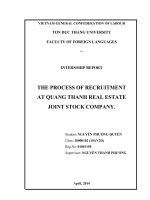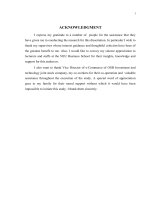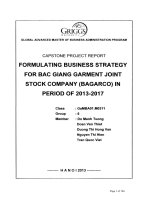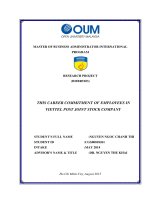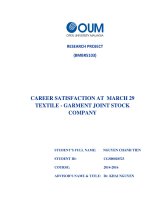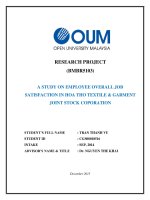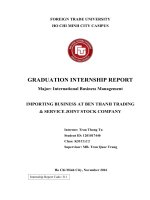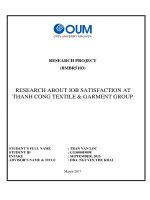Career satisfaction at march 29 textile garment joint stock company
Bạn đang xem bản rút gọn của tài liệu. Xem và tải ngay bản đầy đủ của tài liệu tại đây (1.29 MB, 69 trang )
RESEARCH PROJECT
(BMBR5103)
CAREER SATISFACTION AT MARCH 29
TEXTILE - GARMENT JOINT STOCK
COMPANY
STUDENT’S FULL NAME:
NGUYEN CHANH TIEN
STUDENT ID:
CGS00018523
COURSE:
2014-2016
ADVISOR’S NAME & TITLE: Dr. KHAI NGUYEN
Advisor’s Assessment
---------------------------------------------------------------------------------------------------------------------------------------------------------------------------------------------------------------------------------------------------------------------------------------------------------------------------------------------------------------------------------------------------------------------------------------------------------------------------------------------------------------------------------------------------------------------------------------------------------------------------------------------------------------------------------------------------------------------------------------------------------------------------------------------------------------------------------------------------------------------------------------------------------------------------------------------------------------------------------------------------------------------------------------------------------------------------------------------------------------------------------------------------------------------------------------------------------------------------------------------------------------------------------------------------------------------------------------------------------------------
Advisor’s signature
2
ABSTRACT
The purpose of this study was to test the relationship between the variables in the
model study with the overall satisfaction of work. Results empirical studies were
conducted in Hachiba Company with 291 employees being asked. Research
methodology uses quantitative research methods with multivariate statistical
techniques such as using Cronbach’s Alpha testing, exploring factor analysis,
correlation analysis and linear regression, analysis of variance. Research results show
that all four elements of the research model :
Career Satisfaction (CJ)
Career – Family Attitude (CF)
Developmental Experiences (DE)
Fairness In Skill Based Pay (FP)
Perceived Ability – Job Fit (PJ).
Among the factors considered are demographic factors showed that age that affect
relationships and work colleagues. The study also gives some recommendations
implications for managers in order to raise the level of satisfaction with the work of
employees. Finally the study also points out the limitations and future research
directions for the same research.
Keywords: Career Satisfaction , Career – Family Attitude, Developmental
Experiences, Perceived Ability – Job Fit, Fairness In Skill Based Pay.
3
ACKNOWLEDGEMENTS
During the implementation of this thesis, I have received much help from many people.
Without that help, I can not finish my thesis, so I would like to express thanks to all of
you.
I know that this project is not my personal achievement, but the result of many people
that I will be forever grateful. In particular, I would like to express my sincere gratitude
to my family during theses.
Special thanks to Dr. Khai Nguyen has guided me from the start of this journey, and
always being there to share experiences and his guidance. I also thank the other
members of my guide and my classmates. Each person has assisted in the development
and evaluation of this project, and I really thank them all.
Sincerely thanks !
4
CONTENTS
ABSTRACT ........................................................................................................... 3
1. Introduction ...................................................................................................... 8
1.1 The foundation of research ................................................................................ 8
1.2 Company introduction ....................................................................................... 10
1.3 Problem statement ............................................................................................. 17
1.4 Research Objectives .......................................................................................... 18
2. LITERATURE REVIEW ................................................................................. 19
2.1 Career Satisfaction ............................................................................................. 19
2.2 Career – Family Attitude ................................................................................... 21
2.3 Developmental Experience ................................................................................ 23
2.4 Perceived Ability – Job Fit ................................................................................ 23
2.5 Fairness In Skill Based Pay ................................................................................ 25
3. RESEARCH MODEL AND HYPOTHESES .................................................. 27
3.1 RESEARCH MODEL ....................................................................................... 27
3.2 RESEARCH HYPOTHESES ............................................................................ 27
3.3 INSTRUMENTS ............................................................................................... 29
3.4 RESEARCH DESIGN ....................................................................................... 35
3.5 RESEARCH METHODS ......................................................................................... 35
5
4. DATA ANALYSIS AND REPORT .................................................................. 36
4.1 Descriptive statistics .......................................................................................... 37
4.2 Correlations Matrix............................................................................................ 38
4.3 Cronbach’s Alpha .............................................................................................. 39
4.4 Hypothesis testing results .................................................................................. 40
5. DISCUSSION AND CONCLUSIONS .............................................................. 46
5.1 DISCUSSION ................................................................................................... 46
5.2 SIGNIFICANCE OF RESEARCH .................................................................... 47
5.3 LIMITATION OF THE STUDY ....................................................................... 48
5.4 CONCLUSIONS ............................................................................................... 48
5.5 FURTHER RESEARCH DIRECTION.............................................................. 49
REFERENCE ........................................................................................................ 50
Appendix 1: Survey Questionnaires ......................................................................... 54
Appendix 2: Presentation Slides .............................................................................. 60
6
LIST OF TABLE
Table 01: Descriptive statistics ................................................................................. 7
Table 02: Correlations Matrix ......................................................................................................... 8
Table 03: Cronbach’s Alpha ............................................................................................................ 9
Table 04: Multiple Regression of Hypothesis 1 ............................................................................... 40
Table 05: Multiple Regression of Hypothesis 2 ............................................................................... 41
Table 06:Multiple Regression of Hypothesis 3 ................................................................................ 42
Table 07: Multiple Regression of Hypothesis 4 ............................................................................... 44
7
CHAPTER 1: INTRODUCTION
1. INTRODUCTION
1.1 The foundation of research
The trend of regionalization and globalization more physical ports on competitiveness
among enterprises. To maintain and develop the market, all businesses need to
maintain and enhance the power to have an advantage over other businesses and any
competitors and confirms its position. The changes in the business sector must accept
that the only advantage as well as the most sustainable advantage is the human factor.
Any change in the business sector, the pressure on the company, request a change,
needs people to actively creative, using advanced technology, create new products and
new services to meet the growing needs of customers. Meanwhile, this also requires
companies that to attract workers with higher qualifications, maintain and improve
human resources.
One of the first criteria to assess the quality of the investment climate is labor
resources. It is impossible for a business to make a breakthrough if their employees are
not eligible or are not honest. The workers' organizations must be proficient to
maximize their strength.
According to experts, human resources, assess job satisfaction of employees is an
important task for an entrepreneur to develop a sustainable workforce. Of course, this
task must be performed on a number of criteria for the different positions and must be
carried out periodically. It does no good if a recruit staff without a job description.
Because without a job description, the candidate can not imagine their duties in an
interview and after being recruited, it is very difficult during later work. Besides, the
appointment of a location, the leader must consider the characteristics of an employee
8
to perform the most appropriate coordination between different people with different
characteristics in order to create a good team (which everyone else can accomplish).
In the context of direct competition today, there are many reasons for an employee may
waive his work, such as feeling dissatisfied with material benefits, are not respected, no
share from supervisors, no motivation, no chance to develop, no training, no clear
policy, strict supervision, collaboration from peers, injustice, bad working environment
, no democracy, etc. If the workforce is not planned efficiently, businesses will be
faced with a problem of human problems.
In Vietnam, the study of satisfaction of employees (if any) can only be done within the
HR department. This is still pretty much limited experience, costly and time
investment, no concrete results have to do with the goal, not the human resources
department to create enough influence to convince s successful operation.
Black & Porter (2000) suggests that all the activities in an organization can be traced to
the involvement of people in the organization. The determinants of job satisfaction has
been extensively studied in many developed countries in the world (Cranny et al.
1992).
Similarly, Ting (1997) states that the empirical evidence consistently shown that job
characteristics such as satisfaction with salary, advancement opportunities, a clear
mandate and the relationship with colleagues and directors police have a major impact
on job satisfaction of employees. Also, a study conducted by Ellickson and Logsdon
(2002) reflects that the job satisfaction of employees was significantly affected by the
perception of satisfaction of employees on wages, opportunities development,
relationship with supervisor, employee performance management system and welfare.
9
1.2 Company introduction
MARCH 29 TEXTILE - GARMENT JOINT STOCK COMPANY establish under
number 9312 / QD-Committee dated 29/12/2006 of People's Committee of Da Nang
City transforming 100% state capital into Joint stock Company. Before the move
operating company named Company of the port number 29/3 Textile Industry. Da
Nang city water established by Decision so3156 / QD-UB
11/03/1992 of People's Committee of Quang Nam Da Nang formerly
Textile 29/3, Da Nang city water established in 1976.
Official name: MARCH 29 TEXTILE - GARMENT JOINT STOCK COMPANY
International Business name: MARCH 29 TEXTILE - GARMENT JOINT STOCK
COMPANY
Company names referred to are: HACHIBA
Address: So60 Me Nhu, Thanh Khe Ward, Hai Chau District, Da Nang City
Telephone: + 84 (0511) 3756999
Fax: + 84 (059) 759,622
Website: www.hachiba.com.vn
www.hachiba.vn
E-mail:
Hachiba currently has more than 600 employees with labor qualification structure is as
follows:
Labour male proportion 74.45%; labor famale 25.55% rate.
10
Workers with college degrees in the proportion of 20 1.54%
Workers with university degrees is 601 people proportion 46.23%
Workers with college degrees is 147 percentage of 11.31%
Labour has an intermediate level, workers are 532 people proportion 40.92%
Company leaders include President and Director of the Company; 01 inspectors; 04
Deputy Director of the Company; 01 full-time trade union chairman and Deputy
Secretary of Party Committee of the Company.
Image01 : Hachiba
The development stage of the Company:
Phase from 1976-1978:
11
On 29/03/1976 an anniversary of the Liberation of the People's Committee of Quang
Nam - Da Nang has signed a decision to establish "The complex weave cotton towels
29/3". This is the first stage in the training of skilled workers and guidance acquainted
with machinery. Total initial capital of 20000 dollars, the total number of workers 58
people. Is the primary routes in this phase is difficult to serve the market presence
inland.
On 28.11.1978 officially signed province decided to move "Sets 29/3 cotton towel
woven "into" public-private enterprise 29/3 ".
Phase from 1979-1984:
During this period the enterprise has made steady step, done already diversifying
product mix by producing extra towels meet water . Domestic demand and exports
began to participate.
On 03/29/1984 at the time PPC has decided to move factories a "textile factory 29/3"
operation aimed mainly handling food jobs for the labor force of the province, raising
incomes for the workers employees in the factory. During this time the plant repeatedly
exceeded and until the end of 1984 the plant was the industrial sector is the leading
vote and be State Labor Medal Class II.
The period from 1985-1988:
In conditions of severe deprivation and also the abundant one level economy, home
Machine was pleased to make a pilot for a new management mechanism. With the
arrangement, technical improvements technical, technological change has spurred the
development of production. During these years factory always exceeded production
output year after year
12
Previous and products exporter to market has the Soviet Union and eastern countries
Europe. This is a flourishing period of the plant.
Phase from1989-1992:
State 1986 switch mechanism, remove the subsidy mechanism as replacement
Batch of policy mechanisms: taxation, finance ... making plant having very many
difficulties. Competition in the domestic market has stiff, material prices as so main
raw guava, chemicals ... rising. In overseas markets, the USSR, Germany unilateral
termination of the contract. Facing this situation, the plant decided. Downsized to
invest to produce garments.
On 03.01.1992 by decision so315 / City People's Committee of UBND Da Nang
factory was renamed the "Company Textile 29/3", with the trade name Hachiba
business, an organizational have legal status, have the right and means conservation
and development funds are allocated. Having autonomy in all aspects freezing their
production and business.
Phase 1993 so far:
This is the period of agricultural products trading company constantly development,
the company's increasingly rich and diverse with many new categories, such as
washcloths, khaki pants, shirts ... Markets are Morong to many countries, Japan,
Australia, Taiwan ... Especially in recent years Public
Company has completed in excess of planned production expansion conditions
premises manufacturing, equipped machinery more productive and higher quality.
Besides, the Company was focused on training to improve skills workers, gradually
stabilize and grow.
13
Under Decision so9312 / QD-Committee of the Municipal People's Committee
Da Nang December 29, 2006 to approve the equitization plan.
1/4/2007, 29/3 Textile Co. officially renamed "JSC Textile 29/3 "and running hot with
new leadership.
Products and services :
Textiles towels: Production of all kinds of towels: hand towels, bath towels, towel
Cutting ring, handkerchief, towel Jacquard ...
Apparel: Producing all kinds of garments: trousers, khakis, wash, the clothing for
sports, Jackets ...
Export and import of products and raw cotton scarf apparel Textile materials, Sewing
14
Image02 : showroom of Hachiba
Mission:
Joint stock Company is a single-Visan Textile 29/3 manufacturing, exporting cotton
towels and garments. With deer systems for equipment, with skilled workforce, sense
of good labor and management hot sun, the Company wishes want to meet the highest
demands of customers.
Business Orientations 2008-2010:
The company continued to invest in the remaining items of the project relocation and
reorganization of production has been approved by Da Nang People's Committee
Decision so1662 / QD-UB dated 08/03/2005
15
Construction complete fire protection systems throughout the region Base production
water system, cooling, handle their waste water ... ensuring standards and
environmental engineering
Continue synchronize technological lines and equipment fit requirements of the textile
sector in the integration process, ensuring no impact big production plans. The
company has plans to build a hostel to stabilize security in 500 high-skilled labor
Duties and powers of the Company:
Mission:
Manufacturing and trading of items towel: face towel, printed towel, towel shower…
Manufacturing business of exporting garments: shirts, pants can Sport, kaki pants,
jackets ...
Ever-improving technology and enhancing quality production products to meet the
increasing demands of customers. Develop markets, expanding cooperation with the
countries with countries in the region and around the world.
Resolve jobs for local workers and create conditions to improve the quality of life of
employees.
Donate a portion of the State budget
Power:
As commodity business unit is planning to meet demand growing field. Have legal
personality and an independent economic accounting, self business owners, are direct
import and export rights. To be entitled to extend, Home hot all forms of joint venture,
16
linking research institutions, groups of fish or the organization's scientific progress to
meet new science and technology.
Proactively identify funding to implement the program production joint venture,
association other business establishments. To be entitled to borrow, trade foreign
currency at banks, entitled warlords Joint stock capital, external loans and noisy
convention officers and employees of the Company.
Having autonomy balance production capacity, perfect product structure as required by
new technology processes, develop products to improve the quality of products.
Having the right to organize production management business towards entry effective,
proactive planning business production.
1.3 Problem statement
In this thesis, the main motive is to promote research I:
human resources.
is the lack of qualified and skilled, working conditions and high-risk
evaluation system personnel not close, not create incentives for staff.
faction of employees in Hachiba.
In addition, the development of a research program on the satisfaction of employees in
apparel companies in Vietnam during this period is very important. After years of
work, the managers and the staff was trying to operate and develop the company.
However, recently, while the managers were trying to promote the business, they face
17
trouble with human resources. Specifically, there are many employees increasingly
dissatisfied with the work on the impact on business performance and image of the
Company.
1.4 Research Objectives
affects job satisfaction, such as: wage policy, work experience, balance family and
work job
18
CHARPTER 2 : LITERATURE REVIEW
2.1 Career Satisfaction
Career satisfaction is an important topic in career research because subjective feelings
of success are related to many facets of work behaviour and well-being (e.g., Abele &
Spurk, 2009; Ng, Eby, Sorensen, & Feldman, 2005). Our knowledge about how career
satisfaction develops over time is still very limited. However, applied psychology and
career research (cf. Hall, 2002; Roe, 2008; Van Der Heijden, Schalk, & van
Veldhoven, 2008) call for more studies that explicitly address the role of time and
focus on the question ‘what happens’ rather than ‘what is’ (cf. Roe, 2008). A
developmental and applied perspective on career research requires measurement tools
that are reliable for assessing mean change over time (cf. Chan, 1998).
Career satisfaction as individuals’ idiosyncratic evaluations of their own careers is
often seen as one central indicator of subjective career success (Abele, Spurk, &
Volmer, 2011; Boudreau, Boswell, & Judge, 2001; Judge, Cable, Boudreau, & Bretz,
1995; Ng et al.,2005). It is the evaluation of an individual’s progress towards meeting
different careerrelated goals (e.g., income, achievement, development) and careerrelated successes (e.g., overall career success; see also Hofmans, Dries, & Pepermans,
2008). The Career Satisfaction Scale (CSS; Greenhaus, Parasuraman, & Wormley,
1990; Hofmans et al.,2008) is a widely accepted measure of career satisfaction.
The present research analyses the adequacy of the CSS for measuring mean change
over time. First, we will test its longitudinal measurement invariance. Second, we will
analysis intra-individual change trajectories in career satisfaction by means of multiple
indicator latent growth model (MLGM; Chan, 1998). Theoretical implications with
respect to career satisfaction and, more generally, to subjective career success as well
as different types of change processes, namely alpha, beta, and gamma change (cf. de
19
Jonge, van der Linden, Schaufeli, Peter, & Siegrist, 2008; Golembiewski, Billingsley,
& Yeager, 1975) will be discussed.
Measurement invariance can be considered as the degree to which measurements
conducted under different conditions show identical psychometric properties (cf.
Cheung & Rensvold, 1999). In longitudinal measurement invariance analyses, these
different conditions refer to the different times of measurement. By placing equality
constraints on specific model parameters, three different forms of measurement
invariance can be tested. Two of these forms, namely weak and strong measurement
invariance, provide a qualitative understanding of the underlying construct (Chan,
1998; Cheung & Rensvold, 1999; Wu, Chen, & Tsai, 2009). Specifically, in case of
career satisfaction weak invariance would mean that the relative importance of single
items measuring career satisfaction does not change over time (Steenkamp &
Baumgartner, 1998). Strong invariance would mean that the stability of the latent
career satisfaction construct over time is not due to response biases (Cheung &
Rensvold, 1999). The third form, strict invariance, tests whether the reliabilities of the
single items are the same over time.
Golembiewski et al. (1975) have introduced a taxonomy of change processes (i.e.,
alpha, beta, and gamma change). Quantitative changes are called alpha change defined
as ‘a variation in the level of some existential state, given a constantly calibrated
measuring instrument related to a constant conceptual domain’ (cf. Golembiewski et
al., 1975, p. 134). In case of alpha change individuals’ increase or decrease in career
satisfaction can be clearly interpreted as a quantitative ‘more’ or ‘less’ of satisfaction
over time.
Alpha change, however, can only be meaningfully interpreted as true change in the
absence of beta and gamma change. Beta and gamma change provide further
information about change processes of the underlying construct (de Jonge et al., 2008).
20
Beta change is defined as ‘a variation in the level of some existential state, complicated
by the fact that some intervals of the measurement continuum associated with a
constant conceptual domain have been recalibrated’ (cf. Golembiewski et al., 1975, p.
135). Weak and strong invariance demonstrates the absence of beta change (Chan,
1998; de Jonge et al., 2008).
Furthermore, equal CSS factor variances over time are an indicator for the absence of
beta change (de Jonge et al., 2008; Schaubroeck & Green, 1989). For example, in the
case of beta change individuals might readjust the relative importance of different
aspects of career satisfaction like, for instance, autonomy becoming more important
over time.
Gamma change is ‘a redefinition or reconceptualization of some domain, a major
change in the perspective or frame of reference within which phenomena are perceived
and classified, in what is taken to be relevant in some slice of reality’ (cf.
Golembiewski et al., 1975, p. 135). A test for gamma change would test for equal
factor variances within each time point and for the same factorial structure across
different time points (de Jonge et al., 2008; Schaubroeck & Green, 1989). We here
propose a one-factorial construct of career satisfaction and we will therefore test for the
same (one factorial) structure over time (see also Schaubroeck & Green, 1989),
representing an additional test for measurement invariance (Chan, 1998).
2.2 Career – Family Attitude
Companies are increasingly to heart and have a variety of backgrounds to help
employees balance work and family. Feeling stressed because of work - family occurs
also by a factor of demographics of the workforce is changing. Developed by Sanders,
Lengnick-Hall, Lengnick Hall, and Steele-Clapp (1998). It uses 50 items to assess
employee attitudes toward managing their career and family interface. The measure
21
was designed to be gender neutral and to assess not only what respondents expect for
themselves but also what they expect from their spouse in the area of career-family
conflict. The measure includes subscales that assess family-career interface from the
standpoint of the extent to which the respondent defers career matters to take care of
family matters as well as the extent to which a spouse defers his or her career. The
measure covers possible conflicts in the areas of career, household, and child care
responsibilities (family focus); the extent of equal balance in sharing home and career
chores (balance); the extent to which a respondent may pay more attention to career
than to marriage or children (career focus); the extent to which the respondent has
decision power in the household and the spouse defers his or her career to raise
children (dominance); the extent to which a spouse will sup-port the respondent's
career by giving in on issues, moving, and so on (spousal support); and the extent to
which spouses socialize or vacation in-dependent of the other.
Family focus correlated negatively with educational aspirations and an employee's
grade point average. Balance correlated negatively with male gender of respondent and
positively with educational aspirations and a respondent's grade point average. Career
focus correlated positively with educational aspirations and an employee's grade point
average. Dominance correlated positively with being a male respondent and living in a
rural set-ting. Spousal support correlated positively with being male and correlated
negatively with educational aspirations and grade point average. Independence
correlated negatively with being a male respondent and positively with educational
aspirations and grade point average (Sanders et al., 1998). Factor analysis of the scale
items found six factors corresponding to family focus, balance career focus,
dominance, spousal support, and independence.
The family focus factor was subsequently separated into "I defer" and "someone
defers" subscales (Sanders et al., 1998).
22
2.3 Developmental Experience
While education and training are important to skill development, it is also known that
only 10 percent of adult learning happens in the classroom, from books, tapes, or
online learning activities. This is often because learning in these formats is more
passive. Most adult learning, a full 70 percent, happens by doing. Learning by doing
can take place through on-the-job and leadership experiences.
This measure, developed by Wayne, Shore, and Liden (1997), describes the formal and
informal developmental experiences a job affords employees.
The measure focuses on the extent to which an organization makes discre-tionary
investments in formal and informal training and development of an employee.
Reliability Coefficient alpha was .87 (Wayne, Shore, & Liden, 1997).
Validity In a factor analysis of the items used to measure developmental experiences,
perceived organizational support, leader-member exchange (LMX), affec-tive
commitment, intentions to quit, and employee favor-doing, the four items measuring
development experiences loaded on a single factor by themselves. Development
experiences were correlated positively with the number of promotions an employee has
received, perceived organizational support, affective commitment to the organization,
and organizational citi-zenship behavior (Wayne, Shore, & Liden, 1997).
2.4 Perceived Ability – Job Fit
The fit perception involves a cognitive process, in which an individual compares his
needs, aspirations and abilities to the work environment (Cable & Judge, 1997).
Usually formed during individual’s work experience, such perception is influenced by
several sources such as job characteristics, organizational characteristics and the
individual’s interactions with other staffs within the organization (Rynes, Bretz &
23
Gerhart, 1991). Initially, no serious attention was paid to this concept in the studies of
organizational behavior (Ahmed, 1981). It however has been subsequently accepted
when researches found that individuals who could fit into their jobs are more able to
solve various work-related work behavior issues (Forbes & Barret, 1978). Though
earlier conception of person-job fit perception covered several aspects such as
individual’s readiness to carry out job demands; the sense of how well individual’s
abilities and skills are fully utilized in current job; and how much the job is perceived
by individual to provide the opportunity in practicing his or her best skills, Kristof
(1996) has later simplified it as the evaluation of congruence between an employee’s
abilities and his or her job demands. Saks and Ashforth (2002) measured the concept as
the perception of suitability between an individual’s knowledge, skills and abilities
with his or her job requirements; of job’s ability to fulfill an individual’s needs;
suitability of the job; and last but not the least, individual’s perception on the freedom
in carrying out one’s job. Quite close to the definition, Cable and DeRue (2002) have
focused on three levels of fitness or suitability in their effort to explain this concept.
First is the fitness between job demands and individual’s personal skills. Second is the
fitness between individual’s ability and training with the job requirements. And third is
the fitness between individual’s personal skills and educational level with his or her job
demands. Again, all these definitions have highlighted the concept as a subjective
evaluation related to one’s job competency and work effectiveness. Even though it is a
subjective concept, acknowledgment has been made in accepting an individual’s selfreport on his or her level of capability (Artwater, Ostroff, Yammarino & Fleenov,
1998).
Developed by Abdel-Halim (1981), uses five items to assess an employee's perceived
ability-job fit. According to the person environment fit model of stress, whether a
given level of job demands is stressful to a jobholder is determined by his or her ability
24
(or perceived ability) to perform the job (Xie, 1996). Xie and Johns (1995) found that
employees with lower perceived ability-job fit are affected to a greater degree by job
demands than those who have higher job-ability fit. Reliability Coefficient alpha values
ranged from .73 to .74 (Xie, 1996; Xie & Johns, 1995). Validity Xie (1996) found
through factor analysis that perceived ability-job fit, decision latitude, and job demands
were empirically distinct. Perceived Ability job fit correlated positively with job
demands, control, job satisfaction, life satisfaction, age, adequacy of income, and
tenure. Ability-job fit correlated negatively with anxiety and depression (Xie, 1996)
2.5 Fairness In Skill Based Pay
Society constantly growing, the needs of people on the rise both physically and
mentally. However, wages remain important factors, plays a decisive role governance
process human resources of each enterprise and the whole nation.
COMPETITIVE not paid, not paid FAIR is a major cause for the employee to leave the
business, is the cause of yield and high quality, makes now a waste of resources. So
how to solve this important problem?
Fairness in Skill-Based Pay developed by Lee, Law, and Bobko (1998), assesses
perceived fairness in a skill-based pay program. Skill-based pay systems pay
employees for the range, depth, and types of skills applied on jobs. Employee
perceptions of the skill-based pay program are likely to be influenced
by their perceptions that certification procedures are objective and consistent across
people, times, and skills; include opportunities for employees to ask questions about
the decisions made; and incorporate the use of accurate information.
Coefficient alpha for the fairness measure was .80 (Lee et al., 1998).
25
